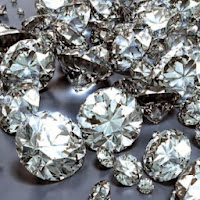Though most people immediately think of diamonds when they think of engagement rings, there are several substitute options like Moissanite or Cubic Zirconia that are just as visually stunning but won’t break your bank. Though the word “fake” often carries along a stigma that leaves a bad taste in the mouth, buying fake engagement rings is becoming more common because it is only the stones that are not real and they look the same as real diamonds but only cost a fraction of the price. Most commonly, your substitute diamonds will be one of two man-made stones; Moissanite or Cubic Zirconia. There are a few differences between these stones and, if you’re in the market, it is important to understand that advantages and disadvantages of each one.
Moissanite as a Diamond Substitute
Though Moissanite is not actually a man-made stone, many people still place it in the “fake” stone category. In reality, it is a rare mineral and its uses date back to the early twentieth century. However, genuine Moissanite is so rare that it is almost exclusively lab-created to fulfill the demands the jewelry industry has placed on manufacturers. Discovered by Henri Moissan around 1900 AD, Moissanite is a mineral that is comprised of silicon carbide. Because of the durable structure containing crystalline polymorphs and it’s completely clear appearance, it is one of the most common synthetic stones produced today and shows up in jewelry designs of nearly every price level.
Furthermore, Moissanite has one of the most brilliant synthetic stones on the market, which makes it one of the most appropriate diamond substitutes available. Registering at 9.25 on the Mohs scale, it is one of the hardest stones available compared to diamonds (10 on the Mohs scale) eclipsing precious stones such as rubies, sapphires, and tanzanite which clock in at a mere 9.0 on the same scale. Some people also believe that Moissanite is a better choice over Cubic Zirconia because it has inclusions instead of being flawless; making it more like a genuine diamond.
Cubic Zirconia as a Diamond Substitute
Probably the best known diamond substitute in the world is Cubic Zirconia, and this is primarily because they are much cheaper than their Moissanite competition. Cubic Zirconia was first introduced in 1974 when manufacturers first started commercial production and they have become increasingly common ever since their inception. Like real diamonds, Cubic Zirconia stones are always cut by individually; but they are also 100% man-made and manufactured to be completely flawless which is virtually impossible in a naturally formed real diamond.
Additionally, Cubic Zirconia stones are not as hard as Moissanite stones and register at 9.0 on the Mohs scale. Also, because they are machine cut rather than cut by hand they tend to be more fragile and are susceptible to having cracks as part of the manufacturing process. However, if you are looking for the best looking ring for your money, many people opt for Cubic Zirconia versus Moissanite because it is much less expensive and there are more options in an affordable price range.
Though the two stones are very similar in appearance, the decision of which to buy comes down to the factors that are most important to you as a consumer. If you want a stone that will be closer in appearance and quality to a real diamond, then you want to go with Moissanite. If price is your primary factor, Cubic Zirconia is the better option because it is the most affordable. Regardless of which stone you choose to purchase, buying substitute diamonds is a great way to save money while still getting all the visual beauty of a genuine diamond.

No comments:
Post a Comment